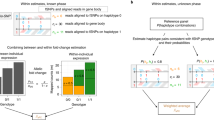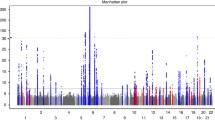Abstract
Although inversions have occasionally been found to be associated with disease susceptibility through interrupting a gene or its regulatory region, or by increasing the risk for deleterious secondary rearrangements, no association study has been specifically conducted for risks associated with inversions, mainly because existing approaches to detecting and genotyping inversions do not readily scale to a large number of samples. Based on our recently proposed approach to identifying and genotyping inversions using principal components analysis (PCA), we herein develop a method of detecting association between inversions and disease in a genome-wide fashion. Our method uses genotype data for single nucleotide polymorphisms (SNPs), and is thus cost-efficient and computationally fast. For an inversion polymorphism, local PCA around the inversion region is performed to infer the inversion genotypes of all samples. For many inversions, we found that some of the SNPs inside an inversion region are fixed in the two lineages of different orientations and thus can serve as surrogate markers. Our method can be applied to case–control and quantitative trait association studies to identify inversions that may interrupt a gene or the connection between a gene and its regulatory agents. Our method also offers a new venue to identify inversions that are responsible for disease-causing secondary rearrangements. We illustrated our proposed approach to case–control data for psoriasis and identified novel associations with a few inversion polymorphisms.

Similar content being viewed by others
References
Ahn SM, Kim TH, Lee S, Kim D, Ghang H, Kim DS, Kim BC, Kim SY, Kim WY, Kim C, Park D, Lee YS, Kim S, Reja R, Jho S, Kim CG, Cha JY, Kim KH, Lee B, Bhak J, Kim SJ (2009) The first Korean genome sequence and analysis: full genome sequencing for a socio-ethnic group. Genome Res 19:1622–1629
Alves JM, Lopes AM, Chikhi L, Amorim A (2012) On the structural plasticity of the human genome, chromosomal inversions revisited. Curr Genome 13:623–632
Antonarakis SE, Rossiter JP, Young M, Horst J, de Moerloose P, Sommer SS, Ketterling RP, Kazazian HH Jr, Negrier C, Vinciguerra C, Gitschier J, Goossens M, Girodon E, Ghanem N, Plassa F, Lavergne JM, Vidaud M, Costa JM, Laurian Y, Lin SW, Lin SR, Shen MC, Lillicrap D, Taylor SA, Windsor S, Valleix SV, Nafa K, Sultan Y, Delpech M, Vnencak-Jones CL et al (1995) Factor VIII gene inversions in severe hemophilia A: results of an international consortium study. Blood 86:2206–2212
Bansal V, Bashir A, Bafna V (2007) Evidence for large inversion polymorphisms in the human genome from HapMap data. Genome Res 17:219–230
Bondeson ML, Dahl N, Malmgren H, Kleijer WJ, Tonnesen T, Carlberg BM, Pettersson U (1995) Inversion of the IDS gene resulting from recombination with IDS-related sequences is a common cause of the Hunter syndrome. Hum Mol Genet 4:615–621
Bosch N, Morell M, Ponsa I, Mercader JM, Armengol L et al (2009) Nucleotide, cytogenetic and expression impact of the human chromosome 8p23.1 inversion polymorphism. PLoS One 4:e8269. doi:10.1371/journal.pone.0008269
Cáres A, Sindi S, Raphael B, Cáres M, Gonzáz J (2012) Identification of polymorphic inversions from genotypes. BMC Bioinform 13:28
Chen K, Wallis JW, McLellan MD, David E, Larson DE, Kalick DJ, Pohl CS, McGrath SD, Wendl MC, Zhang Q, Locke DP, Shi X, Fulton RS, Ley TJ, Wilson RK, Ding L, Mardis ER (2009) BreakDancer: an algorithm for high-resolution mapping of genomic structural variation. Nat Meth 6:667–781
Deng L, Zhang Y, Kang J, Liu T, Zhao H et al (2008) An unusual haplotype structure on human chromosome 8p23 derived from the inversion polymorphism. Hum Mutat 29:1209–1216
Eichler EE, Flint J, Gibson G, Kong A, Leal SM, Moor JH, Nadeau JH (2010) Missing heritability and strategies for finding the underlying causes of complex disease. Nat Rev Genet 11:446–450
Feuk L (2010) Inversion variants in the human genome: role in disease and genome architecture. Genome Med 2:11–19
Gibbs R, Belmont J, Hardenbol P, Willis T, Yu F et al (2003) The international HapMap project. Nature 426:789–796
Gimelli G, Pujana MA, Patricelli MG, Russo S, Giardino D, Larizza L, Cheung J, Armengol L, Schinzel A, Estivill X, Zuffardi O (2003) Genomic inversions of human chromosome 15q11–q13 in mothers of Angelman syndrome patients with class II (BP2/3) deletions. Hum Mol Genet 12:849–858
Kidd JM, Cooper GM, Donahue WF, Hayden HS, Sampas N, Graves T, Hansen N, Teague B, Alkan C, Antonacci F, Haugen E, Zerr T, Yamada NA, Tsang P, Newman TL, Tuzun E, Cheng Z, Ebling HM, Tusneem N, David R, Gillett W, Phelps KA, Weaver M, Saranga D, Brand A, Tao W, Gustafson E, McKernan K, Chen L, Malig M et al (2008) Mapping and sequencing of structural variation from eight human genomes. Nature 453:56–64
Knoll JH, Nicholls RD, Magenis RE, Graham JM Jr, Lalande M, Latt SA (1998) Angelman and Prader–Willi syndromes share a common chromosome 15 deletion but differ in parental origin of the deletion. Am J Med Genet 32:285–290
Korbel JO, Urban AE, Affourtit JP, Godwin B, Grubert F, Simons JF, Kim PM, Palejev D, Carriero NJ, Du L, Taillon BE, Chen Z, Tanzer A, Saunders AC, Chi J, Yang F, Carter NP, Hurles ME, Weissman SM, Harkins TT, Gerstein MB, Egholm M, Snyder M (2007) Paired-end mapping reveals extensive structural variation in the human genome. Science 318:420–426
Lakich D, Kazazian HH Jr, Antonarakis SE, Gitschier J (1993) Inversions disrupting the factor VIII gene are a common cause of severe haemophilia A. Nat Genet 5:236–241
Levy S, Sutton G, Ng PC, Feuk L, Halpern AL, Walenz BP, Axelrod N, Huang J, Kirkness EF, Denisov G, Lin Y, Macdonald JR, Pang AW, Shago M, Stockwell TB, Tsiamouri A, Bafna V, Kravitz SA, Busam DA, Abril F, Josep F (2007) The Diploid genome sequence of an individual human. PLoS Biol. doi:10.1371/journal.pbio.0050254
Ma J, Amos CI (2010) Theoretical formulation of principal components analysis to detect and correct for population stratification. PLoS One 5:e12510
Ma J, Amos CI (2012a) Investigation of inversion polymorphisms in the human genome using principal components analysis. PLoS One 7:e40224
Ma J, Amos CI (2012b) Principal components analysis of population admixture. PLoS One 7:e40115
Manolio TA, Collins FS, Cox NJ, Goldstein DB, Hindoff LA, Hunter DJ et al (2009) Finding the missing heritability of complex diseases. Nature 461:747–753
Molina O, Anton E, Vidal F, Blanco J (2012) High rates of de novo 15q11q13 inversions in human spermatozoa. Mol Cytogenet. doi:10.1186/1755-8166-5-11
Nair RP, Stuart PE, Nistor I et al (2006) Sequence and haplotype analysis supports HLA-C as the psoriasis susceptibility 1 gene. Am J Hum Genet 78:827–851
Osborne LR, Li M, Pober B, Chitayat D, Bodurtha J, Mandel A, Costa T, Grebe T, Cox S, Tsui LC, Scherer SW (2001) A 1.5 million-base pair inversion polymorphism in families with Williams–Beuren syndrome. Nat Genet 29:321–325
Pang AW, MacDonald JR, Pinto D, Wei J, Rafiq MA, Conrad DF, Park H, Hurles ME, Lee C, Venter JC, Kirkness EF, Levy S, Feuk L, Scherer SW (2010) Towards a comprehensive structural variation map of an individual human genome. Genome Biol. doi:10.1186/gb-2010-11-5-r52
Salm A, Horswell S, Hutchison C, Speedy H, Yang X et al (2012) The origin, global distribution, and functional impact of the human 8p23 inversion polymorphism. Genome Res 22:1144–1153
Sharp AJ, Mefford HC, Li K, Baker C, Skinner C, Stevenson RE, Schroer RJ, Novara F, De Gregori M, Ciccone R, Broomer A, Casuga I, Wang Y, Xiao C, Barbacioru C, Gimelli G, Bernardina BD, Torniero C, Giorda R, Regan R, Murday V, Mansour S, Fichera M, Castiglia L, Failla P, Ventura M, Jiang Z, Cooper GM, Knight SJ, Romano C et al (2008) A recurrent 15q13.3 microdeletion syndrome associated with mental retardation and seizures. Nat Genet 40:322–328
Sindi S, Raphael B (2010) Identification and frequency estimation of inversion polymorphisms from haplotype data. J Comp Biol 17:517–531
Small K, Iber J, Warren ST (1997) Emerin deletion reveals a common X chromosome inversion mediated by inverted repeats. Nat Genet 16:96–99
Turner DJ, Shendure J, Porreca G, Church G, Green P, Tyler-Smith C, Hurles ME (2006) Assaying chromosomal inversions by single-molecule haplotyping. Nat Meth 3:439–445
Tuzun E, Sharp AJ, Bailey JA, Kaul R, Morrison VA, Pertz LM, Haugen E, Hayden H, Albertson D, Pinkel D, Olson MV, Eichler EE (2005) Fine-scale structural variation of the human genome. Nat Genet 37:727–732
Acknowledgments
This work has been supported by NIH grant R01CA134682. JM also acknowledge the support provided by the Biostatistics/Epidemiology/Research Design (BERD) component of the Center for Clinical and Translational Sciences (CCTS) for this project. CCTS is mainly funded by the NIH Centers for Translational Science Award (NIH CTSA) grant (UL1 RR024148), awarded to University of Texas Health Science Center at Houston in 2006 by the National Center for Research Resources (NCRR) and its renewal (UL1 TR000371) by the National Center for Advancing Translational Sciences (NCATS).
Author information
Authors and Affiliations
Corresponding authors
Electronic supplementary material
Below is the link to the electronic supplementary material.
Supplemental Data.
Supplemental Data include eight tables.
Online Resource 1: Table S1. List of inversions with surrogate SNPs including known inversions from the DGV and those predicted using the PCA-based approach.
Online Resource 2: Table S2. Inversions significantly associated with psoriasis observed from the original data set.
Online Resource 3: Table S3. Inversions significantly associated with psoriasis observed from the replicate data set.
Online Resource 4: Table S4-S8. Inversion-genotype frequencies for the five inversions identified to be significantly associated with psoriasis.
Rights and permissions
About this article
Cite this article
Ma, J., Xiong, M., You, M. et al. Genome-wide association tests of inversions with application to psoriasis. Hum Genet 133, 967–974 (2014). https://doi.org/10.1007/s00439-014-1437-1
Received:
Accepted:
Published:
Issue Date:
DOI: https://doi.org/10.1007/s00439-014-1437-1




